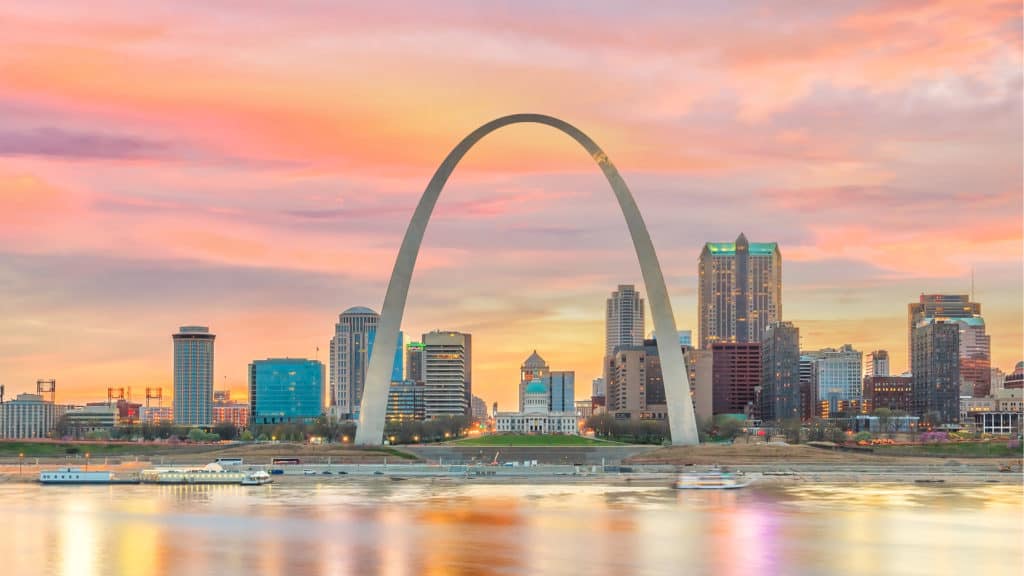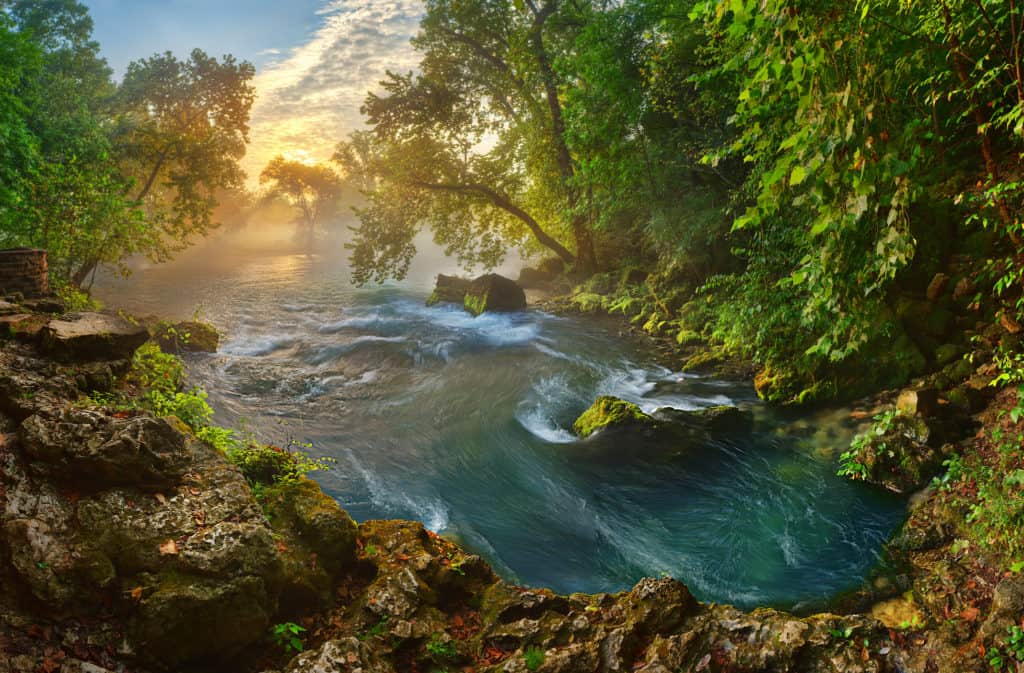Few monuments in the U.S. are as iconic and recognizable as the Gateway Arch in downtown St. Louis, Missouri’s Gateway Arch National Park. At 63-stories high, the swooping stainless-steel arch is the tallest manmade monument in America and has a bold legacy to match its commanding stature. In October of 2020, it celebrated its 55th birthday — a bit over a year-and-a-half after the 91-acre surrounding site was designated a National Park.
Head to the park to see the magnificent structure designed by Eero Saarinen, one of the world’s greatest architects; get an awesome bird’s eye view of St. Louis from the top of the arch; and delve into two very important aspects of American history — the 19th-century exploration of the American west (the park is near the starting point of the Lewis and Clark Expedition, commissioned by President Thomas Jefferson to explore and map out the western part of the country just after it was acquired) and the historic legal debate over American slavery (the park incorporates the Old Courthouse where a landmark freedom-from-slavery case was tried).
Exploring the Gateway Arch by Tram
Because of its location, the arch is also known as the Gateway to the West. During a visit, you’ll be experiencing the spot where the push into the American west began. Imagine yourself standing at the opening to a massive shimmering ‘gate’ beyond which half the country sprawls — lands that, prior to 1803, when Jefferson bought them from France through the Louisiana Purchase deal, were virtually unknown to the pioneers.
Take a four-minute trip to the top of the arch in a unique tram that leads to a stairwell leading up to an observation deck. As you travel upward, the windows in the tram capsule will let you see the interior of the arch —a series of stainless-steel triangles that get increasingly narrow as you climb. It’s really cool to be able to see the inside of the structure, but the real payoff comes at the top: The observation deck, 630 feet above the ground, is peppered with windows that let you look out westward across St. Louis and Missouri, and westward toward the Mississippi River and Illinois. If you go on a windy day, you’re likely to feel the arch sway a bit, which while a little frightening is completely normal, it’s designed to move with the wind.
While you’re visiting, be sure to stop by the Museum at the Gateway Arch where six themed exhibit areas cast light on the pioneering spirit of Native Americans, explorers, settlers and rebels over a period of 201 years. To learn more about the design vision for the Arch and how it was built, head to the Gateway Arch Visitor Center to watch the 35-minute documentary film Monument to the Dream; it plays every hour.
Other Ways to Experience the Gateway Arch

For a very different perspective on the Arch, take a helicopter tour around it, from April-November. You can buy tickets at the helicopter pad on the riverfront below the Arch. Or take a riverboat cruise on the Mississippi River on a 19th-century steamboat replica — you’ll not only get great views of the Arch but also see the St. Louis riverfront. You can also go on a guided tour of the park with a National Park Service Ranger.
Visit the Old Courthouse Where Americans Made Civil Rights History
If the Gateway Arch makes a keenly modern statement with its spare design, cutting-edge engineering and commemoration of new horizons and adventurous exploration, the park’s other significant structure, the Old Courthouse, is similarly an architectural masterpiece that honors American freedoms, but in a more historical guise.
The building is currently closed to visitors, but anyone who is interested in the historic resistance to slavery should come here, walk around and stand on the steps where slaves were auctioned in estate settlements (the building was not only a courthouse but also a public forum). Listed in the National Park Service’s National Underground Railroad Network to Freedom, the Old Courthouse is the site of some of the nation’s most significant legal challenges to slavery—literally hundreds of suits for freedom. The most famous of these suits won the freedom of Dred Scott and his wife Harriet in 1847 but, on appeal, the Supreme Court decided that slaves were property and had no right to sue—that fateful decision and the uproar over it fueled the start of the Civil War. A legal battle for voting rights also took place here — Virginia Minor’s 1870 case for a woman’s right to vote.
Late in 2021, a two-year renovation project will be underway, adding new galleries and updating existing ones. In addition to exhibits focused on Dred and Harriet Scott, architectural features of the courthouse, African American life in St. Louis and slavery, visitors will be able to experience an 1850s courtroom and re-enact mock trials.
Relax and Unwind on the Gateway Arch Park Grounds
Gateway National Park is not only an amazing place to be inspired by architectural wonders and American history; it’s a great spot to enjoy outdoor space (bring your dog, too!). The park features more than five miles of walking, jogging and cycling pathways (fully accessible to all) that offer great views of the Arch, the riverfront and the grounds, which include beautiful reflecting ponds and more than 4,000 trees. If you want to get a sense of species that are native to Missouri, this urban oasis is the place! The North Gateway area of the park also incorporates a kid play area — the Lewis and Clark Explorers’ Garden.
Nearby St. Louis Attractions

With only about 90 acres to explore, the Gateway Arch National Park is one of the smallest parks in the system. The arch is nestled in the heart of downtown boarded by the Mississippi River to the east and some of St. Louis’ most iconic landmarks to the west, making it an easy spot to launch a larger city excursion. Here are some of the best nearby local attractions.
St. Louis Cardinals at Busch Stadium Baseball Park
Catch a baseball game at Busch Stadium where you can enjoy a beautiful view of the city (including the iconic arch) and eat nachos out of a bowl shaped like a baseball hat. Locals love their team, the St. Louis Cardinals, and you can expect to see eager fans any day of the week. If you can’t make it to the stadium but still want to catch a game, head to nearby Ballpark Village. This sports-themed district packs in restaurants, bars and live entertainment around a massive marketplace sporting TV screens large enough for everyone to see the highlights.
City Museum
The City Museum encourages you to not only touch the exhibits, but climb all over them. Made up of repurposed objects in a building that was a former shoe warehouse, visitors can climb through fantastical landscapes including a shaft system of cave-like caverns, a labyrinth-like treehouse and a giant whale. Other museum highlights include a 10 story spiral slide, a skateless skatepark and the towering “MonstroCity” – a climbable outdoor area suspended several stories in the air.
Anheuser-Busch St. Louis Brewery
Whatever your thoughts on domestic beer are, the brewery experience at Anheuser-Busch’s St. Louis brewery is a fun stop in the historic Soulard neighborhood. The towering brick building is Anheuser-Busch’s largest and oldest brewery site. Take a tour where you’ll learn about how the Mississippi River, a large German immigrant community and natural cave formations came together to help create one of the most iconic American beer brands. Oh, and you’ll get to taste some beer too.
Forest Park
Forest Park is a sprawling green space dotted with historic buildings and attractions, many of which were built for the 1904 St. Louis World’s Fair (officially called Louisiana Purchase Exposition). You could easily spend an entire weekend meandering through the rolling hills, water features and historic buildings. Some of the top sites in the park include the Saint Louis Zoo, the view from Art Hill, the Saint Louis Art Museum, The Muny (America’s oldest and largest outdoor musical theatre) and the beautiful Jewel Box – an Art Deco green house made of iron and glass.
Read Next: Float and Fish the Ozark National Scenic Riverways Park in Missouri – discover favorite float trip spots, waterfalls and caverns.

